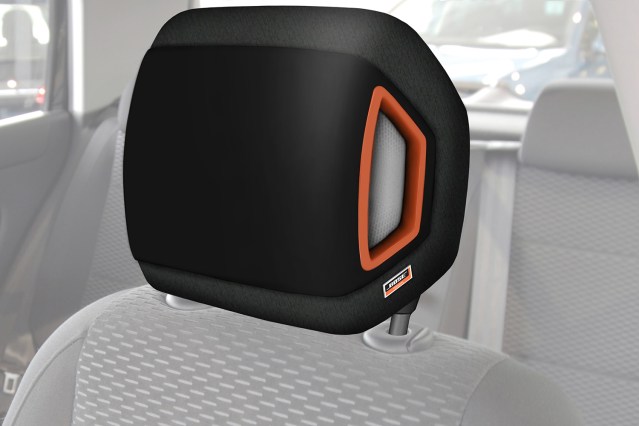Bose sits right up there with Bang & Olufsen, Bowers & Wilkins, and Burmester as a go-to name in premium car audio. Not all of its systems inspire awe, but considering how many companies are willing to slap their name on almost anything, at least Bose can be credited with actually making the systems its name is stamped on. If you’ve got Bose in your car, Bose made the system specifically for that car — and probably charged you a pretty penny for it, too.
Bose is a polarizing name among audio enthusiasts for lots of reasons. But all of those rhymes Bose haters love to spit out on forums? They don’t apply here. Bose has designed four new levels of custom factory car audio solutions that take full advantage of its engineering expertise, the same stuff that makes its headphones and Bluetooth speakers so wildly popular. They start at the affordable Small Car Series, and pile on dollars and drivers until you reach the ritzy and awe-inspiring 34-speaker Panaray system. We heard them all, and we can tell you firsthand that they sound solid and, for many, are worth considering the upgrade … if one is available to you.
Everyman’s Bose
For the first time since it put that original system in a 1983 Cadillac Seville, Bose has a custom audio solution for those of us who drive a Nissan rather than an Infinity. At CES 2016, Bose sat us down in a chromed-out Nissan Juke to give us an example of what a $500 to $600 upgrade might get you in, say, a compact SUV. We were impressed.

The system we heard costs less than half the price of many premium after-market in-dash head units, but sounded like it should cost double. Part of the secret in this car — and in all four of the systems we heard — was speakers Bose cleverly concealed in the driver’s headrest.
The result is a reinforcement and enhancement of the sound coming from the rest of the speakers.
You might be conjuring up thoughts of speakers blaring directly into your ears, but that’s not what’s at work here. In fact, we had to crane our head and plug one ear just to isolate the sound coming from the headrest. That’s because Bose didn’t just stuff some tiny drivers in there and call it a day, but instead developed digital sound processing software that carefully controls what is fed to those speakers and how loud they play. The result is a reinforcement and enhancement of the sound coming from the rest of the speakers in the system. Basically, Bose tricks your brain; in scientific terms, it’s called psychoacoustics.
Instead of feeling like the sound came from the left side of the windshield or somewhere out of the door, it sounded closer to a well configured home stereo system, with soundstage and imaging properties that felt natural and realistic. As a bonus, if a call comes in while you’re listening to music, the system will mute itself and pipe the call through the headrest speakers, lending some privacy to your conversation if you have passengers with you.
And this was the El Cheapo system. Well, Bose calls it the Small Vehicle Series, but you get our drift: It only gets better (and more expensive) from here.
Bose Premium Series
Where the Small Car Series was more upgrade than it was premium, Bose’s step up Premium Series felt more like what you’d expect from a custom-installed audio system. We heard the premium series as installed in a convertible Mazda MX-5. This system involved two 1-inch tweeters in each A-pillar, a pair of the headrest speakers on both the driver and passenger side, two 6.5-inch drivers in each door, and, the kicker, a 5.25 woofer in a 6-liter enclosure hidden in the floor.
It was clear this system had a bit more kick, and the floor-mounted woofer added a palpable sense of bass that punched gently through our seat. Again, the headrest speakers did a lot to improve the sound stage and even give us a sense of sound coming from just behind us. But what really impressed us was the calibration work Bose did to compensate for the absence of the car’s roof. In one swift move, our demonstrator whipped back the convertible top while switching to a second preset. Normally, we’d have experienced a drop in perceived mid-bass, but the new EQ curve did a lot to fill in the gaps. We also noticed a bit of a boost in the headrest speakers, to combat air noise with the top down.
Bose Performance Series
The system was amazingly balanced throughout the vehicle
The Performance series is the level of Bose sound system most folks are familiar with, with a few new tricks thanks to the addition of the headrest speakers. As heard in an Audi A8, this system sounded a bit different than Bose offerings of the past. Bose didn’t say as much, but the Audi the system sounded a little more balanced, though I found myself wishing for a bit more pop in the upper midrange and a bit less emphasis on the very top end. Still, it was a powerful sounding system, capable of reaching extremely high volumes with little perceived distortion. I just wished the sound curve was more to my liking.
Outside of the frequency-response curve, the system was amazingly balanced throughout the vehicle, with headrest speakers installed in the rear locations, considering this sort of vehicle might frequently be carrying a VIP passenger who might need to take a call over the car’s system or simply enjoy all the benefits the audio system had to offer.
Bose Advanced Technology Series, or ‘Holy s#*t that sounds good!’
Finally we arrive at Bose’s pride and joy, the Bose Panaray system for Cadillac, first announced in 2015 as part of the first-ever Cadillac CT-6. We heard the system in this Caddy, and we can confidently say you’ve never heard anything this advanced from Bose before. We’d put Panaray right up there with top-notch Levinson and Bang & Olufsen systems, but what puts Bose ahead, we feel, is the way the company seems to have figured out how to mitigate the cabin of the vehicle as an influencer on the sound quality of the system.
The soundstage was seamless, the imaging was convincing, the bass was deep, punchy, and downright explosive, and the midrange was transparent. Only once or twice (depending on the style of music being played) did we ever feel like the tweeters were a little hot. Most of the time they didn’t call attention to themselves and served the music well.

There are speakers and speaker arrays everywhere in this car, with subwoofers both in the floor and in the back of the vehicle ensuring even bass response everywhere in the cabin. If you’ve ever wondered what it would be like to be wrapped in a cocoon of premium sound, sit yourself down in a Panaray-equipped CT-6 and find out for yourself.
The Panaray system is exclusive to Cadillac, but Bose intends to offer similar systems, customized for each specific luxury vehicle, later this year and going forward. They won’t be called Panaray, but they will be of the same pedigree — and worthy of the no-doubt substantial upgrade fee they require.
Editors' Recommendations
- CES 2021 and cars: What we expect in autonomous cars, EVs, and more
- At CES 2020, BMW will make sleeping in a city car sound attractive
- Bosch is detonating mini-explosions in electric cars to make them safer






